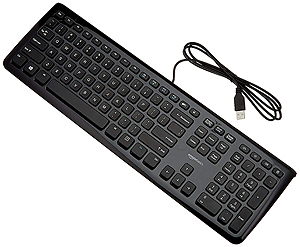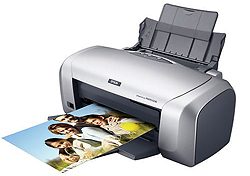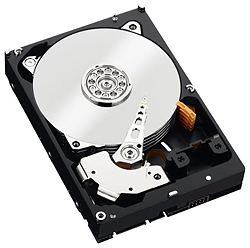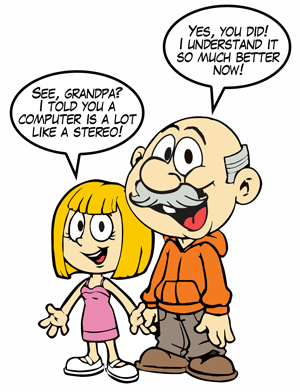Part 3 - What is computer hardware?
Written by Eric Muss-Barnes, 5 December 2018You are here! Thank you! I'm so impressed! I figured most people were going to skip right over this lesson. Now, I know what you're thinking. This is stupid. You already know the basics of computer hardware. If you didn't know the basics of computers, you wouldn't be able to get on the Internet and read these articles or watch my videos in the first place! Right?
Well, no.
Not true.
Let me explain why I want to teach the basics of computers, before I teach you how to build a website.
When I taught my basic web development course at Disney, I was once asked to do a special session for a bunch of the lawyers. Now, you would think a room filled with corporate lawyers, who are employed by Walt Disney Studios, would be some really smart and educated people. But, when I told them to open a file in a text editor, at least three of them had no idea what I was talking about.
Think about that.
Three corporate lawyers... at Disney... couldn't open a file!
They spent all their lives double-clicking on files, so they had no idea how to use an open dialog.
That is why I need to teach some computer basics, before I teach you how to build a website. Because a trio of very-non-computer-savvy lawyers at Disney taught me, even educated and smart people, may lack some fundamental knowledge of how to use a computer.
So, we are going to start at the very beginning. Here we go...
 WHAT IS A COMPUTER?
WHAT IS A COMPUTER?
By the most basic definition, a computer is a machine which allows you to electronically save, retrieve and create information.
That is it.
Pretty simple.
WHAT KIND OF INFORMATION DOES A COMPUTER STORE?
Computers can store and modify a vast array of information, from typed documents, to photographs, to video and audio. The information stored in the computer can be anything from a novel, to a movie, to a piece of music, to records of your taxes, to personal letters with friends and family. Any information you can view on paper, read in a book, watch on television, or hear on radio, can all be stored and retrieved from a computer.
WHAT ARE COMPUTERS COMPUTING?
My grandfather asked me that question once. What was I computing? Because of the name "computer", he perceived a computer as a really sophisticated calculator. Technically, grandpa was absolutely correct. A computer is a sophisticated calculator, but he didn't really grasp the potential of what this sophisticated calculator is capable of doing. As I said, a computer is an apparatus which electronically manipulates and archives information. When these electronic pieces of information are being stored or displayed, the machine has to mathematically calculate, or "compute", how to present that data. That is why computers are called "computers" - because they are constantly computing how to record or show the information you are requesting.
 WHAT IS A COMPUTER SYSTEM?
WHAT IS A COMPUTER SYSTEM?
The easiest way to explain a computer system is to use the analogy of a stereo system.
Even if you have never personally owned a large stereo system, they are so ubiquitous in the modern world, you have undoubtedly seen one at some point.
A stereo system is comprised of multiple pieces of equipment called "hardware". The hardware in a basic stereo system might just be a radio tuner and speakers. You can also add more hardware like a turntable, an equalizer, a cassette deck, a CD player and so forth. All of those components are separate pieces of machinery, and although a stereo system doesn't require all of that hardware to function, each component you add, upgrades the overall capabilities of your stereo system.
The media you play on your stereo, such as vinyl record albums, cassette tapes, compact discs, 8-track tapes and so forth, is called "software".
Changing that media could often be a tedious and repetitive task.
 When turntables were invented, engineers designed a spindle allowing you load multiple record albums, so the machine could automatically play them in sequence. The same thing happened with compact discs. The first compact disc players, or CD players, could only play one CD at a time. Eventually, CD changers were invented, which could store 5 or 10 or even 100 CDs inside the machine itself. All of your software was now physically stored inside your stereo system. That way, your stereo system could access your entire CD collection, without forcing you to walk over to the stereo and constantly insert new music into the machine, one disc at a time.
When turntables were invented, engineers designed a spindle allowing you load multiple record albums, so the machine could automatically play them in sequence. The same thing happened with compact discs. The first compact disc players, or CD players, could only play one CD at a time. Eventually, CD changers were invented, which could store 5 or 10 or even 100 CDs inside the machine itself. All of your software was now physically stored inside your stereo system. That way, your stereo system could access your entire CD collection, without forcing you to walk over to the stereo and constantly insert new music into the machine, one disc at a time.
Computer systems are very similar to stereo systems. Computer systems also use hardware and software.
Just like a stereo system, computer systems are comprised of a variety of hardware components, which you can choose to upgrade, thereby improving the capabilities of the system.
A basic computer system consists of four hardware components called a "monitor", a "keyboard", a "mouse", and the "computer" itself.
 The part that looks like a television screen is called a "monitor". The monitor image will change to display whatever information you tell the computer to show. Using the monitor, you can see text and images of all the items you have stored in that computer. Naturally, these pieces of hardware have all evolved over the past few decades, just like every technology. Lightweight and thin LCD monitors of today look very different than the heavy CRT monitors from 20 years ago, but they still serve the identical function and purpose.
The part that looks like a television screen is called a "monitor". The monitor image will change to display whatever information you tell the computer to show. Using the monitor, you can see text and images of all the items you have stored in that computer. Naturally, these pieces of hardware have all evolved over the past few decades, just like every technology. Lightweight and thin LCD monitors of today look very different than the heavy CRT monitors from 20 years ago, but they still serve the identical function and purpose.
 You also have a "keyboard", which is just like the keyboard on a typewriter. In fact, the keys on a computer keyboard are arranged in exactly the same order as those of a typewriter. There are a few extra computer-specific keys as well, but a majority of the keyboard looks just like a typewriter. The keyboard allows you to type commands to the computer system and is one of the primary devices you use to control the computer. You can use the keyboard to create new information or retrieve stored information. With the keyboard, you can compose a novel, play games, use a calculator, or name the information you want the computer to save.
You also have a "keyboard", which is just like the keyboard on a typewriter. In fact, the keys on a computer keyboard are arranged in exactly the same order as those of a typewriter. There are a few extra computer-specific keys as well, but a majority of the keyboard looks just like a typewriter. The keyboard allows you to type commands to the computer system and is one of the primary devices you use to control the computer. You can use the keyboard to create new information or retrieve stored information. With the keyboard, you can compose a novel, play games, use a calculator, or name the information you want the computer to save.
 The next component is the "mouse". A mouse is a device which allows you to move and control elements on the monitor screen. Since we are focused on a broad overview of the physical hardware components right now, I won't go into a lot of details about how a mouse interacts with a monitor, but we'll come back to it in a future article. So, if you don't quite understand what I mean, don't worry. Just know that the mouse moves elements around on the monitor, and I'll explain that in more detail later.
The next component is the "mouse". A mouse is a device which allows you to move and control elements on the monitor screen. Since we are focused on a broad overview of the physical hardware components right now, I won't go into a lot of details about how a mouse interacts with a monitor, but we'll come back to it in a future article. So, if you don't quite understand what I mean, don't worry. Just know that the mouse moves elements around on the monitor, and I'll explain that in more detail later.
 Finally, there is the actual "computer" itself. The computer contains all the electronics to make information appear on the monitor. It also processes your input from the mouse and the keyboard, to perform the tasks you are requesting. On many computers, the internal electronic components can also be changed and upgraded. Specific parts inside your computer control sound capabilities, certain components control the image quality on the monitor, some control the amount of information the computer can store, and so forth. Just like you can change parts in the engine of a car, to upgrade the performance characteristics of a vehicle, you can also change the parts inside a computer, to make it run more efficiently for your needs.
Finally, there is the actual "computer" itself. The computer contains all the electronics to make information appear on the monitor. It also processes your input from the mouse and the keyboard, to perform the tasks you are requesting. On many computers, the internal electronic components can also be changed and upgraded. Specific parts inside your computer control sound capabilities, certain components control the image quality on the monitor, some control the amount of information the computer can store, and so forth. Just like you can change parts in the engine of a car, to upgrade the performance characteristics of a vehicle, you can also change the parts inside a computer, to make it run more efficiently for your needs.
There you have it.
Those four things are the primary components of a typical home computer system. Monitor. Keyboard. Mouse. Computer.
 Just like a stereo system, you can add more hardware to change the capabilities of your computer system. Many computers will also include some kind of "disk-drive", which can both play and record, compact discs or DVD discs. While compact discs and DVD discs were originally invented to store music and movies, they can also store electronic information to use in a computer. Different computer systems incorporate disk-drives in different ways. Some computers have a disk-drive built into the computer itself, while others have a separate, external disk-drive which plugs into the computer.
Just like a stereo system, you can add more hardware to change the capabilities of your computer system. Many computers will also include some kind of "disk-drive", which can both play and record, compact discs or DVD discs. While compact discs and DVD discs were originally invented to store music and movies, they can also store electronic information to use in a computer. Different computer systems incorporate disk-drives in different ways. Some computers have a disk-drive built into the computer itself, while others have a separate, external disk-drive which plugs into the computer.
 A more advanced computer system might include a small "printer", used to print out documents and photographs, or a device called a "scanner", similar to a photocopier, which will scan a paper document and create a digital copy inside the computer.
A more advanced computer system might include a small "printer", used to print out documents and photographs, or a device called a "scanner", similar to a photocopier, which will scan a paper document and create a digital copy inside the computer.
You might want to connect your computer to the Internet, so you would add a device called a modem.
You might want to record music with your computer, so you would add a microphone, or a device that plugs into an electric guitar.
You might want to edit old home movies on your computer, so you would add a device that connects your computer to your VCR or videocamera.
And so on, and so forth.
 WHERE DO COMPUTERS SAVE THEIR INFORMATION?
WHERE DO COMPUTERS SAVE THEIR INFORMATION?
Excellent question. Remember when I mentioned CD changers allow your stereo system to store a massive amount of media?
Computers contain an important piece of hardware inside the machine itself, called an internal "hard-drive", which functions in a way very similar to a CD changer. The biggest difference is that a CD changer holds the original copy of the media and a hard-drive holds a duplicate copy. An internal hard-drive is known as a "storage device" because it physically stores electronic information on it, using a magnetic charge.
HOW DO COMPUTERS SAVE INFORMATION MAGNETICALLY?
 You may be familiar with the function of analog magnetic storage devices such as audio cassette tapes, video tapes, and reel-to-reel. All of these technologies work in a similar fashion. They contain a length of plastic tape, coated with a thin film of magnetized particles. When you record onto the tape, music or video is encoded into an electrical signal, which is transformed into a magnetic charge, and stored on the reel. When you play the tape, that magnetic charge is converted back into an electrical signal, used to replicate sound or images.
You may be familiar with the function of analog magnetic storage devices such as audio cassette tapes, video tapes, and reel-to-reel. All of these technologies work in a similar fashion. They contain a length of plastic tape, coated with a thin film of magnetized particles. When you record onto the tape, music or video is encoded into an electrical signal, which is transformed into a magnetic charge, and stored on the reel. When you play the tape, that magnetic charge is converted back into an electrical signal, used to replicate sound or images.
The hard-drive inside a computer works in a similar way. Instead of a magnetic tape, a hard drive contains very tiny, spinning platters, made of metal, which might only be an inch or two in diameter. These platters also become magnetized, just like a cassette tape. The magnetic charges recorded on a hard-drive allows for staggering amounts of information to be stored inside of a computer. Newer storage devices have no moving parts at all. These are called "solid-state drives" or an SSD. Just like a traditional hard-drive, an SSD can hold an incredible amount of data. The quantity of this data is measured on a scale called "bytes".
1024 bytes equals 1 kilobyte or 1KB.
1024 kilobytes equals 1 megabyte or 1MB. This is about the equivalent of storing one 300-page novel worth of text.
1024 megabytes equals 1 gigabyte or 1GB. Incredibly, this is about the size of 1000 novels!
1024 gigabytes equals 1 terabyte or 1TB. This is enough data to store around 256 full-length movies.
These days, in 2018, most computers include a hard-drive hundreds of gigabytes in size. 256GB or 512GB are a common size for new hard-drives in a new system. Right off the bat, even a low-end computer has the capacity to store around 512,000 novels worth of information.
Collectively, this overall size capacity is often called "memory". Computers contain specific types of memory, in different parts of the hardware, for different purposes. Those details are not important. Just know the term for holding information in your computer is known as computer "memory".
 Many years ago, a girlfriend asked me about the risk of information degrading when copying data on a hard-drive. This was an excellent question. Let me explain why computers don't suffer from this problem. You first need to know the difference between analog and digital recordings.
Many years ago, a girlfriend asked me about the risk of information degrading when copying data on a hard-drive. This was an excellent question. Let me explain why computers don't suffer from this problem. You first need to know the difference between analog and digital recordings.
Magnetic tape usually stores the magnetic charge in an analog way.
Hard-drives store their magnetic charge in a digital way.
What does that mean and why is this distinction important?
When you make a copy of a VHS tape or cassette tape, and make a copy of that copy, and a copy of that copy, the quality of the recording will degrade with each subsequent duplicate. This is known as "generation loss". In the most simplistic terms, the reason generation loss happens is because the analog magnetic charge consists of a waveform, which varies and fluctuates in intensity. As this waveform is read, and decoded, and transformed back into a charge on the second, or third, or fourth tape, detailed nuances of the signal end up being lost over wiring and circuits, because of the nature of electricity. As a result, video images get fuzzy, and audio starts to sound muffled, because the dynamic range of the recording is slightly reduced, each time you copy a copy.
That is why generation loss happens.
Digital storage devices, such as computer hard-drives, do not store an analog waveform of magnetism. Instead, digital recordings are magnetically storing a complicated series of binary numbers. Therefore, when you copy information in a computer, and make a copy of that, and a copy of that, all of the subsequent duplicates are identical to the original. There is no generation loss in a computer, because everything is a digital number, not an analog waveform.
WHY DO YOU NEED TO STORE THAT MUCH INFORMATION ON A COMPUTER?
People use computers to store all sorts of things. Books. Photographs. Videos. Music. Games. Legal documents. You name it. Just like physical filing cabinets in the real world, the more bytes your hard-drive contains, the more documents you can save on your computer. If you use computers to work with music or video, you might need several terabytes of storage, because recording music and images electronically requires a massive amount of data to be saved and retrieved.
 Let me give you a quick example. As I'm sure you know, a television image is made up of thousands of tiny dots called pixels. Digital cameras also store images in the form of pixels. The more pixels in an image, the more computer memory is required to store all that information of dots. Now, imagine the high detail and sharp resolution of a movie being projected on a movie screen. There are a massive amount of pixels in each frame of that movie, so a computer system used to edit a movie can quickly start to require staggering quantities of memory and storage.
Let me give you a quick example. As I'm sure you know, a television image is made up of thousands of tiny dots called pixels. Digital cameras also store images in the form of pixels. The more pixels in an image, the more computer memory is required to store all that information of dots. Now, imagine the high detail and sharp resolution of a movie being projected on a movie screen. There are a massive amount of pixels in each frame of that movie, so a computer system used to edit a movie can quickly start to require staggering quantities of memory and storage.
 There are many variations of storage devices available for a computer. In addition to the internal hard-drive, you can also add an external hard-drive, if you need more storage capacity. There are even tiny storage devices that can fit on your keychain and store massive quantities of information.
There are many variations of storage devices available for a computer. In addition to the internal hard-drive, you can also add an external hard-drive, if you need more storage capacity. There are even tiny storage devices that can fit on your keychain and store massive quantities of information.
Now you know what computer hardware means. When someone talks about upgrading their hardware, they might need a new monitor, or a new keyboard, or a larger hard-drive, or a whole new physical computer box.
To summarize, computer systems store and manipulate a wide format of information from text to photos to sound.
Computer systems are a lot like stereo systems.
Stereo systems are comprised of multiple devices called hardware.
Computer systems are also comprised of multiple devices called hardware.
The media we play on a stereo system, such as records and cassette tapes, are software.
Computers also use software.
 But I haven't really explained computer software, have I?
But I haven't really explained computer software, have I?
You understand the idea of the physical parts, but what about those electronic functions happening on the monitor screen? When you sit down and look at a computer monitor, what exactly does it show you? How do you type on the screen and interact with it and make it save or retrieve information? How does all of that part work?
Well, let's discuss that in the next article where I will explain computer software.
Thanks for watching.
And remember, kids, the world owes you nothing... until you create things of value.
Glossary
bytes
A measurement of computer data storage capacity.1024 bytes
A term measuring computer storage or memory capacity. 1 kilobyte or 1KB.1024 kilobytes
A term measuring computer storage or memory capacity. 1 megabyte or 1MB. This is about the equivalent of storing one 300-page novel worth of text.1024 megabytes
A term measuring computer storage or memory capacity. 1 gigabyte or 1GB. Incredibly, this is about the size of 1000 novels!1024 gigabytes
A term measuring computer storage or memory capacity. 1 terabyte or 1TB. This is enough data to store around 256 full-length movies.computer
An electronic apparatus used to store, retrieve and create information.disk-drive
An input device allowing you to copy (or "load") information from a computer disk onto the computer hard-drive.hard-drive
A storage device made of spinning, magnetized platters, allowing you to save massive amounts of information inside the computer.hardware
All the physical components that comprise a computer system (e.g. monitors, keyboards, mice, disk-drives, etc.) and all the physical devices inside the computer itself, such as a hard-drive.input device
Any hardware that sends an electronic signal into the computer so you can interact with the machine.keyboard
An input device for a computer allowing you to type commands and compose documents. The layout of a computer keyboard is identical to a typewriter, but contains a few additional keys to activate computer commands.memory
The amount of storage capacity a computer possesses. Depending upon the context of the word "memory", the term refers to different parts of a computer system, including the storage capacity of a hard-drive, or other forms of memory such as that which is accessed on circuit boards inside the computer.monitor
The television screen connected to a computer.mouse
An input device used to navigate and move information around on the monitor image.solid-state drive
A storage device with no moving parts.storage device
Any piece of hardware which stores electronic data in a format a computer can read and understand.Other Articles
